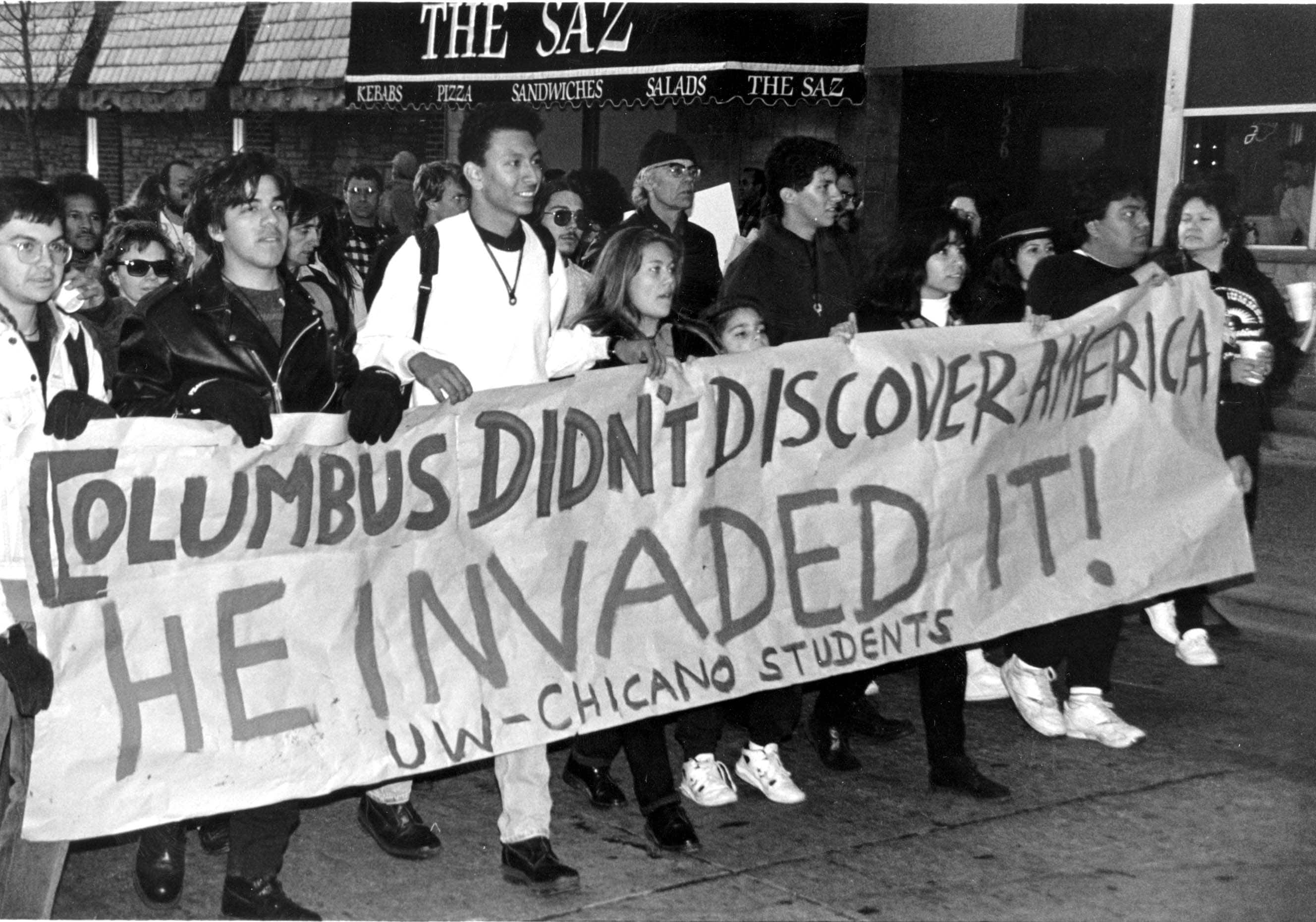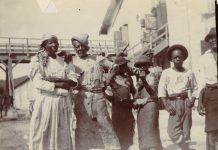
Socialistisk Biblioteks Tidslinje med links til begivenheder og personer i 1492.
Se også Index over personer, organisationer/partier og værker (som bøger, malerier, mm.), steder, begivenheder, mv., der er omtalt på hele Tidslinjen, titler og indhold på emnelisterne osv.
12. oktober 1492
“Indianerne” (beboerne på øen, i dag Haiti) opdager Christoffer Columbus og hans tre skibe.
Links:

- Christoffer Columbus. Af Niels Steensgaard (Denstoredanske)
- Christopher Columbus (Wikipedia.org)
The real Christopher Columbus. By Howard Zinn (Jacobin, 10 October 2016). “There was no heroic adventure, only bloodshed. Columbus Day should not be a celebration.”
The story of Columbus. By Marley-Vincent Lindsey (Jacobin, 10 October 2016). “Popular writers looking to add nuance to the narrative about Christopher Columbus have instead muddied the waters. Here’s a more accurate story.”
A celebration of mass murder (SocialistWorker.org, October 15, 2009). “Dahr Jamail and Jason Coppola document the real history of Christopher Columbus and the conquest of the ‘New World’.”
Columbus and the discovery of Latin America. By Stuart King (Permanent Revolution, 23 August 2008; online at Internet Archive). “Mass killings, slavery and increasingly group suicides by the Arawaks themselves took a terrible toll of Hispaniola’s population.”
History not taught is history forgot: Columbus’ legacy of genocide. By Ward Churchill. Excerpted from the book Indians are Us?: Culture and Genocide in Native North America (Common Courage Press, 1994; online at Justice Initiative International).
Columbus and the conquest of the Americas (Green Left Weekly, Issue 74, 7 October 1992). “The information here was put together by the US organisation Witness for Peace.”
Columbus, The Americas and the rise of Capitalism. By Mike Haynes (International Socialism, Issue 57, Summer 1992; online at Researchgate.net). “This paper explores the rise of capitalism in the Atlantic area using Columbus’s discovery of America as a starting point.”
Columbus & the colonial legacy (New Internationalist, Issue 226, December 1991). “Wayne Ellwood explores the myth of discovery and looks at the famous mariner’s impact on the land and people of the Americas.”
1492: The first invasion of globalization. Noam Chomsky interviewed by Heinz Dieterich (Chomsky.info, 1989/1992). Excerpted from Latin America: From Colonization to Globalization (Ocean Press, 1999). See also Noam Chomsky: Year 501: The Conquest Continues (South End Press, 1992; online at ZNet).
Føderal feriedag i USA siden 1971:
Transform Columbus Day
Litteratur:
Eventyret om Columbus. Af Hans Koning (Københavns Bogforlag, 1991, 120 sider).

Se også:
- Kolonialisme (Leksikon.org)
- Kolonialisme. Af Jørgen Dige Pedersen og Niels Steensgaard (Denstoredanske)
Blood and gold: the Spanish conquest of the Americas. By Jorge Martín and Ubaldo Oropeza
Why do we honor genocide? By Khury Petersen-Smith (SocialistWorker.org, October 9, 2017). “The calls to end the celebration of Columbus Day have a relevance today beyond recognizing the atrocities of European colonialism.”
Privileges and prerogatives granted by their catholic majesties to Christopher Columbus: 1492 (The Avalon Project at Yale Law School)
New World Empires: Maya, Aztec, and Inca. Part 27 in: Neil Faulkner: A Marxist History of the World (Counterfire, 17 January 2011)
The new colonialism. Part 35 in Neil Faulkner: A Marxist History of the World (Counterfire, 12 May 2011)
Columbus, the Indians, and human progress. Chapter 1 in Howard Zinn: A People’s History of United States (HarperCollins, 2003; online at History is a Weapon).
The conquest of the New Spain. Chapter in Chris Harman: A People’s History of the World (pdf) (Bookmarks, 1999, p. 161-172; online at Internet Archive). Scroll down.
American Holocaust: The Conquest of the New World. By David E. Stannard (Oxford University Press, 1992, 358 p.). See excerpts from the book at Third World Traveler.
Latinamerikas åreladning. Af Eduardo Galeano (Internationalt Forum, 1971/1973, 288 sider). Online in English edition: Open Veins of Latin Amerika (pdf) (Monthly Review Press, 1973, 313 p.; online at Libcom.org/Internet Archive).
!["They would cut an Indian's hands and leave them dangling by a shred of skin ... [and] they would test their swords and their manly strength on captured Indians and place bets on the slicing off of heads or cutting of bodies in half with one blow. ... [One] cruel captain traveled over many leagues, capturing all the Indians he could find. Since the Indians would not tell him who their new lord was, he cut off the hands of some and threw others to the dogs, and thus they were torn to pieces." Date 1590s. Included in later editions of Brevísima relación de la destrucción de las Indias, 1552 by Bartolomé de las Casas. Engraving by Theodor de Bry (1528–1598),Southern Netherlandish engraver, draughtsman, editor and publisher. Public Domain.](https://socbib.dk/wp-content/uploads/2007/12/7-3-1024x816.jpg)

Amerikanske civilisationer før Columbus. Del 1. Af Anders Bæk Simonsen (Socialistisk Arbejderavis, nr. 377, 27. januar 2020) (Almindelige menneskers historie, del 11). “Om maya-civilisationen, der allerede var en kultur i nedgang, da de spanske kolonisatorer satte deres fod i Amerika.”
Amerikanske civilisationer før Columbus. Del 2. Af Anders Bæk Simonsen (Socialistisk Arbejderavis, nr. 378, 17. marts 2020) (Almindelige menneskers historie, del 12). Om “de to andre udviklede civilisationer, nemlig aztekerne og inkaerne.”
Se også:
Tidslinjen 16. november 1532, om Inka-rigets fald.






























![A demonstration of workers from the Putilov plant in Petrograd (modern day St. Peterburg), Russia, during the February Revolution. The left banner reads (misspelt) "Feed [plural imperative] the children of the defenders of the motherland"; the right banner, "Increase payments to the soldiers' families - defenders of freedom and world peace". Both refer to the economic toll the First World War was having on civilian life, February 1917 (probably around March 7 [O.S. February 22]) Photo: Unknown. Public Domain.](https://socbib.dk/wp-content/uploads/2007/04/1917-februarrevolution2.1500x0-100x70.jpg)